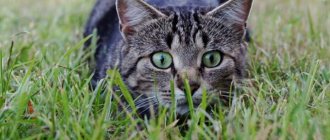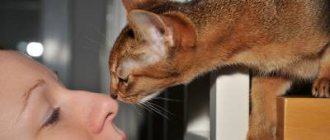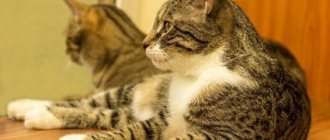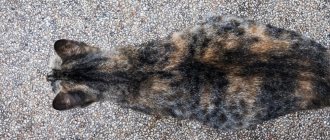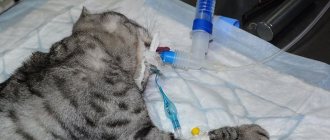Cats infected with toxoplasmosis often show no symptoms. In rare cases, cats develop lethargy, gastrointestinal problems, or even respiratory problems. Many cats will remain silent carriers their entire lives.
People can become infected with toxoplasmosis after handling cat litter containing the parasite and accidentally ingesting the microscopic cysts. They can also get it from eating contaminated meat.
Symptoms of toxoplasmosis in humans include fever, headache, lethargy and muscle pain. Toxoplasmosis may not actually cause any symptoms in people.
Warning: However, it can cause serious complications in pregnant women and people with weakened immune systems.
Intestinal parasites in cats
Many rodents are infected with common intestinal parasites such as roundworms. Intestinal parasites can cause diarrhea, vomiting and weight loss. Some intestinal parasites can be transmitted to other pets or people in the home.
If your cat goes outside or is known to have parasites, routine fecal testing for intestinal parasites is recommended. Your veterinarian may prescribe antiparasitic medications to deworm your cat. In addition, your cat will receive monthly heartworm and flea prevention with each dose.
How to teach a cat to catch mice - step by step instructions
It is best to teach a kitten to catch mice. But you can teach this to an adult cat. The scheme will be approximately the same.
- Catch the mouse yourself and show it to the cat. Give your pet the opportunity to look, smell, and play with the rodent. For the first acquaintance, you can use a dead mouse. It is important that at this stage the cat learns who she will have to deal with in the future.
- Carry out a series of active games with a dummy mouse that is as close as possible to a real rodent. Tie it to a rope and give the cat the opportunity to “hunt”. At the same time, develop your pet’s dexterity, because mice are very sneaky animals. Using bait, train your cat to overcome various obstacles. You can do this in places where you often encounter rodents. Just remember to keep your cat safe.
- Provide your cat with a scratching post so she can keep her claws ready, and regularly provide dry food or large pieces of meat to self-clean her teeth and keep them sharp.
If a cat becomes interested in mice, then perhaps she will soon awaken a desire to catch one of the individuals as a gift for you.
Plague bacteria in cats
Some rodents carry plague, an infection caused by the bacteria Yersinia pestis. 4 These are essentially the same bacteria that caused the infamous “Black Plague” of the Middle Ages. Plague is often spread by fleas, but cats can become infected by eating the meat of infected animals (often small mammals).
Cats infected with Yersinia pestis may experience lethargy, depression, loss of appetite, vomiting, diarrhea, cough, muscle soreness, and fever. The cat may develop swollen lymph nodes, lesions in the mouth, and weight loss.
Treatment includes the use of antibiotics and supportive care. The sooner treatment can be started, the higher the chances of survival.
People rarely become infected with the plague. When they do become infected, it is usually through a flea bite. Symptoms and treatment are relatively similar to those in cats.
Gender of the animal
It is believed that females are more prone to catching mice than males. The fact is that cats have a highly developed sexual instinct, which sometimes prevents them from fulfilling their hunting duties. But the cat, on the contrary, is more inclined to hunt, because She has a nature to feed her offspring in the future. Of course, during estrus, the pet is unlikely to think about mice, but this period does not last long, and soon the cat is ready for exploits again.
In general, animals of both sexes will be able to catch mice, it’s just that males will do it more for fun, and females, even sterilized, will obey the survival instinct.
Hantavirus infections
Several species of rodents are known to carry hantavirus. Cats can be infected with hantavirus but do not show any symptoms, so the virus is not harmful to them. Additionally, cats cannot transmit hantavirus to humans.
However, humans can be exposed through contact with infected rodents. 6 Although serious complications caused by hantavirus are uncommon in humans, exposure can lead to a serious illness called hantavirus pulmonary syndrome.
Breeds of rat-catching cats
There are certain breeds in the cat family, whose representatives are distinguished by excellent health, special dexterity and dexterity in catching rats.
Siberian cat
The cat was named Siberian due to its fluffy long hair. She is unpretentious, has a strong build, the weight of cats reaches 7 kg, cats weigh about 9 kg. She has strong paws and excellent grip. Due to the slightly longer hind legs compared to the front legs, the cat has the ability to run and jump quickly. Such animals are obstinate in nature, they have an excellent reaction, which is necessary when catching rats. They are independent and love freedom.
The Siberian cat has a strong build and excellent grip.
Maine Coon
Cats of this breed are distinguished by mobility and strength. Maine Coons are hardy and able to live in regions with harsh climatic conditions. These large animals (males can weigh up to 15 kg) have the nature of a predator; they do not welcome human affection. Due to their size, they can easily deal with rats.
Maine Coons easily deal with rats
This breed of cat is distinguished by straight-set large ears, which have tassels at the ends. Maine Coons have long and thick fur. They have well-developed muscles, a wide chest, strong bones, and a thick and long tail. All this data allows Maine Coons to become a real threat to rodents.
Kurilian Bobtail
A feature of animals of this breed is a short tail, the length of which does not exceed 3–8 cm. But they have strong hind legs, which are longer than the forelimbs. And therefore the Kurilian bobtail runs well, jumps, and deftly strangles rats. Males of this breed weigh about 10 kg, females - 6 kg.
The Kurilian Bobtail is fearless and deftly strangles rats
Such cats are capable of completely destroying a mouse or rat hole. They are easy to train and can be trained. People keep them as companions; they get along easily with other animals. Bobtails have a fearless character.
European shorthair cat
Representatives of this breed destroyed rodents back in the days of Ancient Rome. European shorthair cats are called yard cats and are not considered purebred. However, they are popular in the world and are one of the best rat catchers. The predator's passion and agility help them successfully hunt rats and mice.
European shorthair cats are some of the best rat catchers.
Such cats are distinguished by individuality, independence, grace, and aristocratic appearance. They have a short coat, gray or silver marbled in color.
Cymric
Animals of this breed are similar to ordinary cats, but with a short tail. This structure, along with agility and tenacious claws, makes the Cymric a successful rat catcher.
Agility and tenacious claws make the Cymric a successful rat catcher.
British Shorthair
The hunting instinct and excellent natural inclinations make the British excellent rat catchers. Such cats are calm, friendly, and attractive in appearance. They love to please their owner by bringing him a caught rodent in their teeth in order to exchange it for rewards and something tasty.
Natural inclinations and hunting instinct make British Shorthairs excellent rodent catchers.
Females, weighing an average of 4 kg, try not to attack large rats, hunting only young ones or mice. Often this is enough to avoid a rodent infestation.
Russian blue
Russian blue cats are medium in size and light in weight, but this does not interfere with their hunting habits. Instant reaction and silent movement for a long time make these cats good rat catchers.
The Russian Blue cat has the ability to move silently and react instantly.
The ability of the Russian Blue to react to rodents is a true art: its speed of attack on the prey, accuracy and grace of movements are captivating. This is a thunderstorm of super rats, weighing about 500 g. The Russian Blue does not like partners of other cat breeds, but gets along well with rat catchers of its own breed. Opponent of tenderness from the owner.
Toxicity of rodenticides
Rodenticide is very toxic to cats. 7 Cats can eat rat poison placed in and around the house. Most often, cats become infected after fully or partially eating a rodent that has ingested rat poison. There are several types of rat poison, so symptoms and treatment may vary. Exposure to rodenticides is very dangerous even in small quantities.
Rodenticides can cause symptoms such as lethargy, gastrointestinal upset, pale gums, drunkenness, seizures, and more. If you suspect your cat has been exposed to rat poison, contact your veterinarian immediately. Aggressive treatment is often necessary.
So that the owner does not die of hunger
The desire to feed the owner is, at first glance, a rather strange, but also quite real motive.
Often cats bring captured rodents and place them directly on the pillow in front of the sleeping person. In this case, there is no doubt that the cat knows that you need his care, and shows it as best he can.
Don't scold your pet if you find such a gift on your pillow. It’s better to carefully get rid of the gift, praise the cat and don’t forget to wash the bed linen, as wild mice can be carriers of various diseases. It will also not be possible to protect yourself from the appearance of such a gift again, since it all depends on the cat’s desire to take care of its owner.
Reasons for behavior
Most often, owners who let their pet outside the premises are faced with the fact that a corpse or half the carcass of a bird or mouse appears in an apartment, country house or dacha. Often, potential cat prey will wander into a city apartment and, having been caught by a furry homebody, will appear on the rug, on the floor, or even in the owner’s bed.
Having discovered a trophy that is valuable from the pet’s point of view in his home, the owner, as a rule, is interested in why cats bring their prey to their owners. There are many guesses about this phenomenon, including incorrect ones.
Some owners mistakenly believe that in this way the pet expresses gratitude for the good attitude towards him, a well-fed and calm life. Others naively believe that signs of attention in the form of the carcass of a caught mouse are a manifestation of love and care for the owner on the part of the cat. However, such explanations do not fully correspond to the motives that prompt the animal to carry a bird or rodent that was caught with difficulty into the owner’s house.
To understand this issue, you must first understand why a well-fed and satisfied pet goes hunting, what prompts the animal to chase a gray mouse with a full bowl of treats?
I bring everything I own home
Of course, the reason for the hunting passion of furry beauties is a strong natural instinct. It is he who pushes even a well-fed domestic cat to an ancient activity - hunting. Being representatives of a large cat family, the pets living with us have not lost the skills of a successful hunter over the centuries of domestication. That is why, even if the bowl is full of the most delicious meat, a domestic cat will not miss the opportunity to hunt a bird or rodent.
The reason that motivates a cat to share its prey with its owner is also based on the instincts laid down by Mother Nature. Zoological scientists put forward several explanations for this behavior of animals, based on scientific data - zoopsychology.
According to one version, the cat, being a territorial animal, is highly dependent on the environment and the room where it grew up and is constantly located. In modern conditions, for a pet, this territory is an apartment, a country house in which it lives. The reason that prompts the animal to bring its prey into the house is often precisely the territorial instinct.
The animal feels that in an alien environment (on the street, in a park, in a garden) the prey can be lost, so it tries to take its trophy to a safe territory that is familiar to it. Being well-fed, not every cat will eat a rodent. Many animals limit themselves only to the excitement of hunting and bring prey to their home.
A killed trophy located on the territory is regarded as a kind of mark for potential enemies. The animal thus shows that this space belongs to it, and all enemies will suffer the fate of prey.
Gift for a friend
Another version of zoologists about why cats bring prey to their owner sounds no less plausible. According to scientists, this behavior of furry pets is due to the fact that a person is the owner, the master, and is perceived by many individuals as a relative.
In the wild, representatives of the cat family often live in families - prides, where there are several mothers raising children. Other members in such a family hunt and bring prey to nursing cats. Owners often become eyewitnesses when a cat father brings a mouse or a bird to a new mother with kittens.
When a cat shares its trophy with its owner, it demonstrates one of the models of such a cat family. According to the pet, the owner is not able to obtain adequate food for himself, and she takes upon herself the responsibility of supplying the family member with provisions.
We recommend reading about why a cat shits on the bed. You will learn about the main reasons for this behavior, the group of animals that most often do this kind of mischief, and methods of influencing a cat. And here is more information about how to stop a cat from tearing up furniture and wallpaper.
Home owner
Do not forget that cats become attached not to the owner, but to the place. In order to show who is boss, they often bring home prey and place it throughout the territory. This is how the cat proves that this territory belongs to her and she can protect it at any time.
Help from mom
One of the reasons why a cat brings mice to its owner is the manifestation of maternal instinct. Especially often the owner is “treated” to his trophy by females with developed maternal feelings. In this case, the animal perceives the person as an object in need of care.
You can often observe the following picture: a cat not only brought a half-dead mouse into the house, but is also trying to “teach” its stupid owner how to hunt it. In this case, the caught prey is regarded as a “teaching tool” for a careless family member who does not know how to catch normal food.
This phenomenon is typical for both unsterilized cats and operated animals. Unable to realize their maternal program, sterilized pets turn all their energy, attention and love to the owner.
Trophy
Some animals bring in prey for collection. Their natural instinct is satisfied, the rodent is caught, the prey is at the mercy of the predator. But why eat it if the house is full of all kinds of delicious things? Let the mouse lie down for a while and then run about its business.
Token of gratitude
Many zoologists and experts in the field of animal psychology believe that the demonstration of hunting achievements in the form of mice, birds and other living creatures brought into the house or even onto the owner’s bed is associated with a feeling of the need to confirm one’s importance for the owner. The pet expresses its gratitude for the food provided to it in such an extravagant way, from the human point of view, and shares its trophy.
The ambiguity of the scientific interpretation of animals demonstrating their hunting victories indicates the versatility of behavioral instincts in cats. The owner’s task is to observe, be attentive and take an interest in the lives of his furry beauties.
To learn why cats carry their prey home, watch this video:
They are trying to feed you and teach you
The cat takes its owner for some semblance of itself. She sees that for some reason her owner does not catch mice, and decides to do this work for him. They say, if he cannot hunt (perhaps due to health reasons or lack of skills), then I am ready to help.
Sometimes a cat, to the horror of the female part of the family, brings a mouse, slightly strangled, but still alive, and proudly presents it. This is a kind of training: she wants you to practice the art of catching rodents with an inactive prey.
